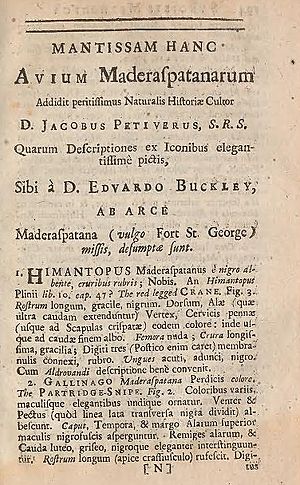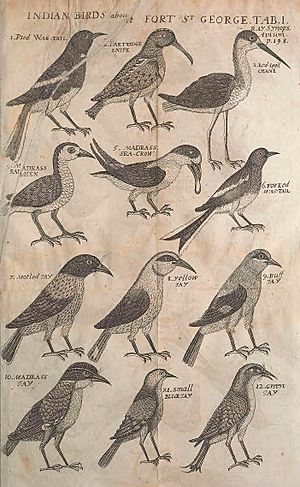Edward Bulkley facts for kids
Edward Bulkley was an important surgeon and a pioneer in studying nature. He worked for the East India Company in a place called Madras (which is now Chennai, India). He was one of the first people to write down information about the birds and plants in India.
Bulkley talked a lot with other scientists. He wrote letters to James Petiver, a famous English naturalist. He was the first to list the different types of birds in India. This list was later published by John Ray, another well-known scientist. Ray accidentally spelled Bulkley's name as "Buckley" in his book.
Bulkley also studied local plants. He worked with a Jesuit botanist named Georg Joseph Kamel. Bulkley helped Kamel and Petiver share information. He also wrote to Charles du Bois about plants. Bulkley even collected the local Tamil and Telugu names for many plants that were used as medicine or were important for the economy.
First Autopsy in India
Edward Bulkley is famous for doing the first complete autopsy in India. An autopsy is a special medical examination of a body after someone has died. It helps doctors understand why the person died.
This important event happened in 1693. A man named James Wheeler, who was part of the Council of Madras, had died. People thought he might have been poisoned. Another doctor, Samuel Browne, had treated Wheeler. Browne's assistant had used a tool that might have had a harmful substance on it.
Bulkley performed the autopsy very carefully. He found out that James Wheeler had not died from poisoning. Because of Bulkley's findings, Doctor Browne was found innocent. Before this, only a small examination of a soldier's head had been done in 1680. Bulkley's was the first time a full body examination was carried out in India.
Sharing Discoveries
Bulkley often wrote to scientists in Britain. He kept sending samples of nature to James Petiver, even after Petiver's earlier helper, Samuel Browne, passed away. Bulkley also sent soil samples from India to John Woodward, another naturalist. Woodward even included Bulkley's soil samples in his own science book published in 1729.
Life in Madras
Besides his scientific work, Edward Bulkley also had important roles in Madras. He was a member of the Council of Madras, which helped govern the area. He also worked as a Paymaster, managing money.
In February 1713, Bulkley had to stop working because he was not well. He passed away on August 10, 1714. He was buried in his own garden in a place called Peddanaikpetta. This area is now part of the Army lines, across from the Madras Medical College.
His tomb has a special message written on it. It says that the monument is for Edward Bulkley, a skilled doctor for the English Company. It mentions that he explored the secrets of nature for a long time. It also says he wanted his body to be placed in his garden, where he enjoyed his time, hoping for a happy resurrection. A sermon for his funeral was given by Rev. William Stevenson at St Mary's church.
Images for kids





